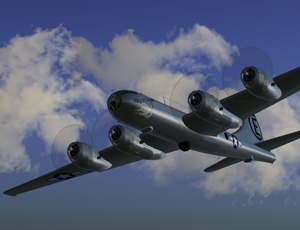Boeing B-29 Superfortress
Jump to navigation
Jump to search
 | |
|---|---|
 | |
| Type | Bomber aircraft, Military aircraft, Historical aircraft |
| Propulsion | Piston aircraft, Four-engine aircraft |
| Manufacturer | Boeing |
| Author(s) |
|
| FDM | YASim, JSBSim |
| --aircraft= |
b29 b29-jsbsim b29-magic b29-yasim b29-wingman |
| Status | Early production |
| FDM |
|
| Systems |
|
| Cockpit |
|
| Model |
|
| Development | |
| Website |
|
| Repository |
|
| Download |
|
| License | GPLv2+ |
|
| |
The Boeing B-29 Superfortress was a four-engine propeller powered heavy bomber that was flown by the United States Military in World War II and the Korean War, and by other nations afterwards (Royal Air Force, Royal Australian Air Force). The name "Superfortress" was derived from that of its well-known predecessor, the B-17 Flying Fortress, and carried on a series of names for Boeing-built bombers followed by the B-52 Stratofortress.
It was the primary aircraft in the U.S. firebombing campaign against the Empire of Japan in the final months of World War II, and carried the atomic bombs that destroyed Hiroshima and Nagasaki.
Aircraft help
| Key | Function |
|---|---|
| Ctrl+D | Toggle bombbay doors |
| Ctrl+F | Toggle cabin doors |
| n/N | Propeller fine/coarse |
| t/T | Adjust turbo pressure |
| j | Jump to next seat |
Start Routine
- increase throttle to one third
- select engine #1
- operate starter
- switch magnetos to ON
- repeat for the engines #2 - #4
Approach
- flap 45 deg
- speed 130-140 MPH IAS depending on auw
- rpm 2100
- turbo setting 0.8
- boost(approx) 10 psi
- touchdown speed: 95 - 110 MPH IAS depending on auw
External links
- Superfortress Wikipedia article
- B-29 Flight Procedure And Combat Crew Functioning (1944) YouTube video (37 min)
| |||||||||||